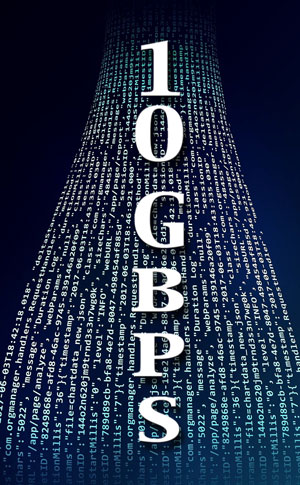By John Shepler
Gigabit internet speed is like the gold standard for high-speed business connections. But sometimes even 1 Gbps isn’t enough, and that’s when you need to consider upgrading to 10 Gigabit Internet.
 Who Needs 10 Gbps Bandwidth?
Most small businesses and almost all residential internet users don’t need this much speed. The bragging rights aren’t worth the high monthly fees. This level of bandwidth is meant for demanding applications that justify the cost.
Who Needs 10 Gbps Bandwidth?
Most small businesses and almost all residential internet users don’t need this much speed. The bragging rights aren’t worth the high monthly fees. This level of bandwidth is meant for demanding applications that justify the cost.
Just a short while ago, 10 Gbps connections were only found in the core networks of telecommunication companies and the internet itself. But times have changed, and what was sufficient a decade ago is now barely adequate. Those 10 Gbps lines have become more widely available and easier for businesses to obtain.
Cloud services, colocation centers, and large corporations with thousands of connected employees need gigabit and 10 gigabit speeds, or even faster. High-tech companies and those using advanced tools might also require these higher speeds. Content providers absolutely need it. And hospitals and medical centers dealing with large imaging files can’t afford to wait for slow transfers.
What’s Involved In Acquiring 10 Gigabit Service? These high speeds are almost always delivered through fiber optic cable. Once fiber is installed, getting high speeds is just as easy as getting slower speeds. This is because fiber optic cable has a very high capacity for data transmission. The limiting factors are the number of fibers in the cable and the equipment at each end.
The first standard for high-speed fiber transmission was called SONET (Synchronous Optical Network) and was developed by telephone companies. You might have heard of OC-192, which is the 10 Gbps SONET Optical Carrier level. These days, most competitive networks, and even the telephone companies, are switching to Carrier Ethernet. Ethernet is directly compatible with almost all local area networks. It can also easily scale from 10 Mbps to 10 Gbps and beyond. What’s even more important for most businesses is that Carrier Ethernet (also called Ethernet over Fiber) is typically more readily available and less expensive than the older SONET technology.
Many regional, national, and international carriers now offer 10 Gig Ethernet access and point-to-point private lines. This means you might have several competitive offers to compare.
Why 10 Gbps Dedicated Internet Access? Imagine the internet as a vast electronic highway system with major interstates and countless on-ramps. Unless you’re a part of the internet’s core infrastructure, you’ll be connecting through one of these on-ramps, and their performance varies greatly.
The best internet performance comes from connecting to the network backbone through a high-tier provider using a dedicated connection. “Dedicated” means that you are the sole user of the bandwidth you’ve leased. This might seem like the standard, but most internet connections designed for consumers and smaller businesses are shared, not dedicated. By combining multiple customers on a single line, cable, satellite, and cellular wireless companies can offer affordable internet connections at reasonable speeds.
Another important factor is symmetric bandwidth. This means you have 10 Gbps for both uploading and downloading data. Those budget-friendly internet options usually have asymmetric bandwidth, with faster download speeds and slower upload speeds.
Bandwidth to Grow With Your Needs Since Carrier Ethernet is easily scalable, you can order the bandwidth you need now and upgrade it later as your business grows. With a 10 Gbps port, you can start with 1 Gbps, 5 Gbps, or another speed, paying only for what you use. As long as you have enough port speed, you can often upgrade with a simple phone call to your provider or even through your online account.
If you’re struggling with limited bandwidth but are worried that the solution is unavailable or too expensive, you might be pleasantly surprised. Go ahead and request competitive quotes from Dedicated Internet Access providers in your area.

